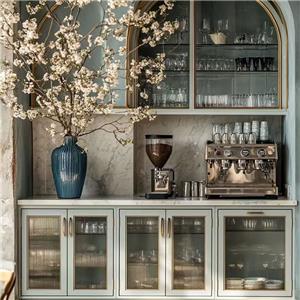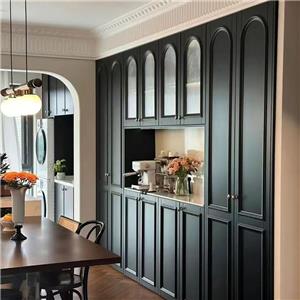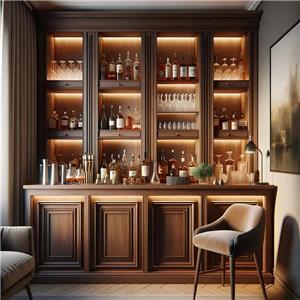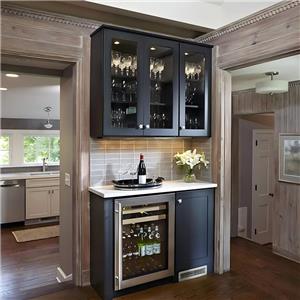How much space should be left between home bar cabinets?
As one of the important decorative and practical furniture in the home, home bar cabinets can not only enhance the overall taste of the home, but also provide a space for the owner to store and display fine wine. However, when installing and placing home bar cabinets, reasonable space reservation is not only related to aesthetics, but also directly affects the convenience and safety of use.
Therefore, how to leave appropriate space between home bar cabinets has become an important issue that many families need to consider when decorating.
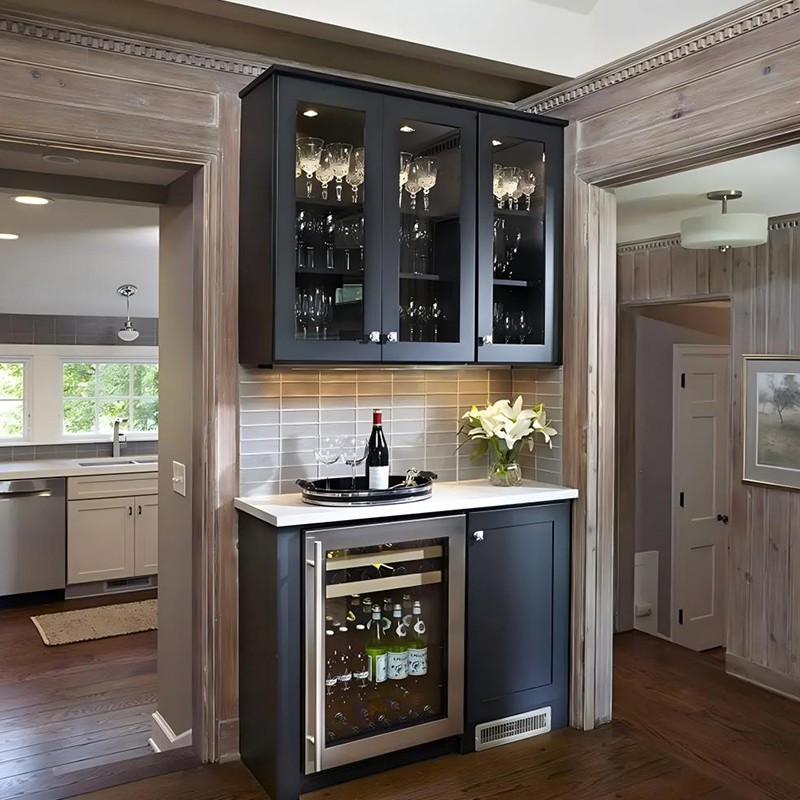
What is the importance of space reservation for home bar cabinets?
The function of home bar cabinets is not only to store wine, but also a display and decoration. Whether it is an independent bar cabinet or an embedded bar cabinet, reasonable space reservation will directly affect the use effect of the bar cabinet and the overall layout of the home.
1. The need for ventilation and temperature control
The interior of the home bar cabinet needs to maintain a certain temperature and humidity to ensure the best storage environment for wine products. If the space between the bar cabinets is too narrow and the air circulation is restricted, it is easy to cause the temperature inside the bar cabinet to be unstable, which in turn affects the preservation effect of the wine. Especially when multiple bar cabinets are placed side by side, poor ventilation may cause problems such as overheating or high humidity.
2. Convenience of operation
The door panels, drawers and other components of the home bar cabinet require a certain amount of operating space when opening and using them. If the distance between two bar cabinets is too close, it may cause inconvenience in operation, or even fail to fully open the cabinet door or drawer, affecting the daily use experience.
3. Safety considerations
Household appliances will inevitably generate heat during use, especially electric bar cabinets. When designing the layout, the heat dissipation problem must be considered. If the space between the bar cabinets is too small and the heat dissipation is not smooth, it may increase the load of the appliances and even cause safety hazards. In addition, in earthquake-prone areas or when there are children in the family, the stability of the placement of the bar cabinet and the space reserved to avoid collision are also crucial.
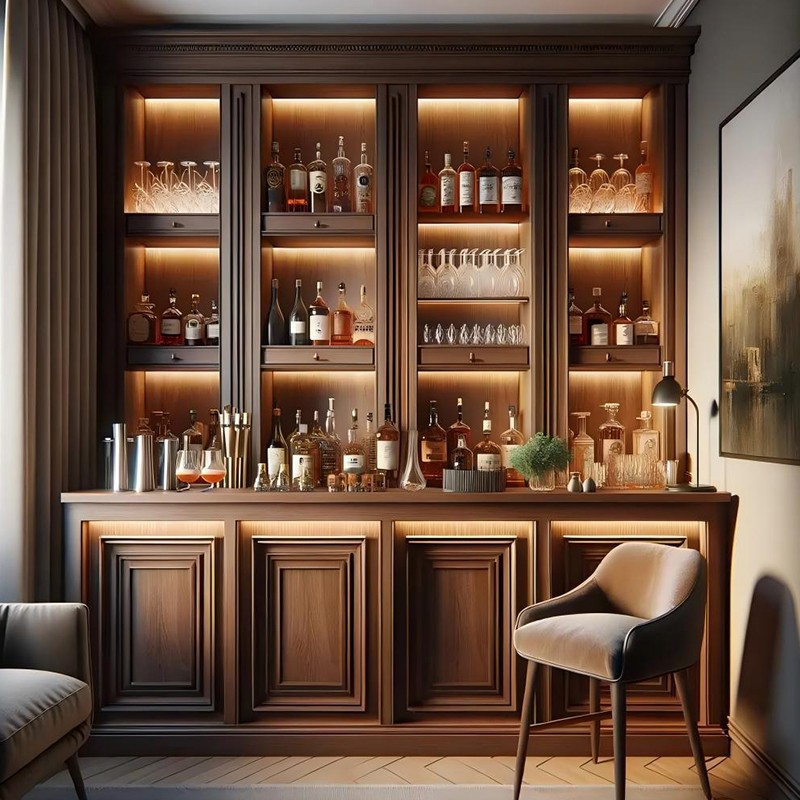
How much space should be left between home bar cabinets?
The space reservation standards between bar cabinets are different for different types of bar cabinets and different home environments. Below we will analyze in detail from three aspects: freestanding bar cabinet, embedded bar cabinet and combined bar cabinet.
1. Freestanding bar cabinet
Freestanding bar cabinet is one of the most common types of home bar cabinets, usually with a separate placement space. The space reserved for a freestanding bar cabinet is mainly concentrated on the sides and back. Generally speaking, in order to ensure the heat dissipation and air circulation of the bar cabinet, at least 5-10 cm of space should be reserved on the left and right sides, and at least 10-15 cm of space is recommended on the back to facilitate wire connection and ventilation.
In addition, if the bar cabinet is located in a corner or other area that is not easily ventilated, it is recommended to increase the spacing between the sides and the back appropriately, or install a small fan at the bottom of the bar cabinet to enhance air flow and prevent overheating.
2. Embedded bar cabinets
Embedded bar cabinets are usually embedded in kitchen cabinets or specially designed home decorations. Since the embedded bar cabinet itself is closely integrated with the cabinet, its space reservation is mainly concentrated on the front and back ends. In order to ensure that the bar cabinet can be installed and removed smoothly, at least 2-3 cm of operating space should be reserved in the front, and 10-15 cm of heat dissipation space should be reserved on the back.
Although it is not necessary to leave a large space on both sides of the embedded bar cabinet, it is recommended to reserve at least 1 cm of gap to prevent friction or interference between the cabinet and the bar cabinet. If the home space allows, the heat dissipation space at the back can be appropriately expanded according to the specific situation to further improve the heat dissipation effect.
3. Combined bar cabinet
Combined bar cabinets are usually composed of multiple small bar cabinets, which can be arranged horizontally or stacked vertically. When reserving space for this type of bar cabinet, special attention should be paid to the spacing between each unit. For horizontally arranged bar cabinets, at least 3-5 cm gaps should be left between units to ensure the independent heat dissipation capacity of each bar cabinet. When stacked vertically, special attention should be paid to the load-bearing capacity of the bottom bar cabinet and the stability of the upper bar cabinet. It is recommended to add 5-10 cm buffer space between each layer of bar cabinets to avoid displacement or falling risks caused by gravity or vibration.
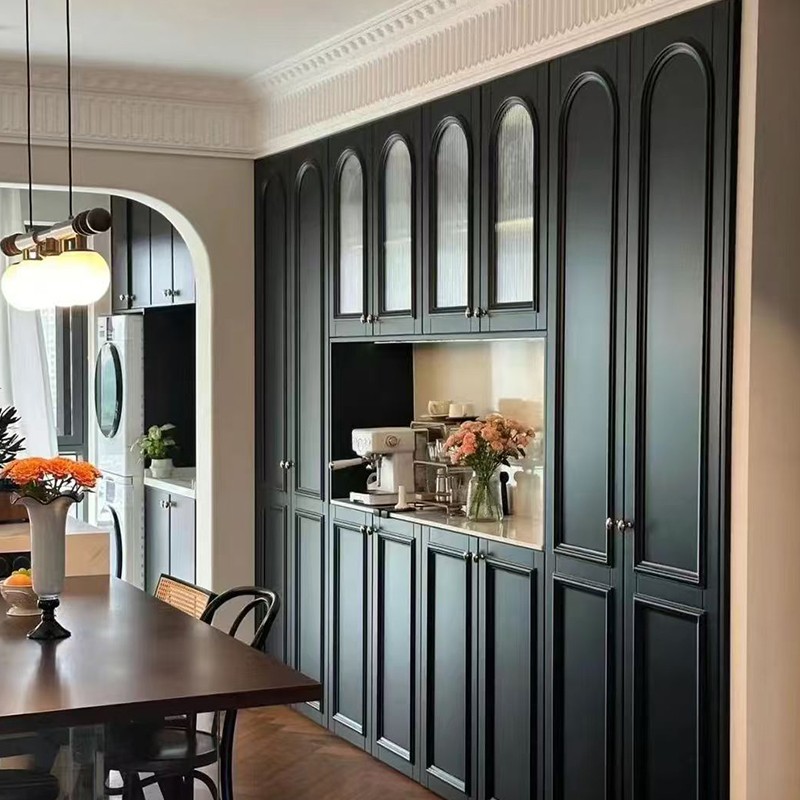
How to adjust the space between bar cabinets according to the home layout?
The space layout and decoration style of each family are different, so when actually installing the bar cabinet, it is necessary to make flexible adjustments based on the specific home layout. Here are several common home layout scenarios and their corresponding bar cabinet spacing adjustment suggestions:
1. Bar cabinet placement in narrow spaces
If the available space in the home is relatively narrow, such as placing a bar cabinet in a corridor or foyer, it is recommended to choose a relatively slim freestanding bar cabinet or embedded bar cabinet. For a freestanding bar cabinet, the reserved space on both sides can be appropriately reduced to 3-5 cm, but the heat dissipation space on the back must still be maintained at more than 10 cm. At the same time, try to avoid placing multiple bar cabinets in a narrow space to avoid affecting traffic or causing a sense of space oppression.
2. Bar cabinet layout in spacious spaces
In a spacious living room, dining room or wine cellar, you can create a more atmospheric visual effect by increasing the spacing between home bar cabinets. For example, a spacing of 10-20 cm can be left between freestanding bar cabinets, which is not only conducive to air circulation, but also visually creates a sense of hierarchy. If the space is spacious enough, you can consider setting up a display stand or decorative partition between the bar cabinets to further enrich the level of the space.
3. Arrangement of bar cabinets in multi-functional spaces
In some multi-functional spaces, bar cabinets may share the same space with other furniture or appliances. At this time, in addition to considering the space reservation between bar cabinets, it is also necessary to consider coordination with other furniture. For example, when the bar cabinet is placed adjacent to appliances such as refrigerators or microwave ovens, it is recommended to maintain a certain distance (at least 15-20 cm) to avoid affecting the use of the bar cabinet due to poor heat dissipation of the appliances. At the same time, there should be enough passage space between the bar cabinet and furniture such as dining tables and sofas to avoid affecting daily life lines.
How to choose the type of home bar cabinet?
In addition to space reservation, choosing the type of bar cabinet suitable for home use is also one of the important factors to ensure its reasonable placement. The following are several types of bar cabinets suitable for home use and their advantages and disadvantages:
1. Mini bar cabinet
Mini bar cabinets are small in size and suitable for placement in a corner of the kitchen, dining room or living room. Due to its small size, the space requirement is relatively low, which is suitable for families with limited space. However, the storage capacity of mini bar cabinets is limited and it is not suitable for families who need to store a large amount of wine.
2. Medium bar cabinet
Medium bar cabinets usually have a larger storage capacity and can accommodate more wine bottles and wine utensils. This type of bar cabinet is suitable for families with certain wine storage needs, but the space requirements are relatively high. Medium bar cabinets usually need to reserve more ventilation and heat dissipation space, so special attention should be paid to the space layout when placing them.
3. Large bar cabinet
Large bar cabinets are suitable for families with a large demand for wine storage or with dedicated wine cellars. This type of bar cabinet usually requires an independent placement space and has higher requirements for heat dissipation and ventilation. Therefore, the space reserved between large bar cabinets needs to be more spacious to ensure its normal operation.
4. Embedded bar cabinet
Embedded bar cabinets are suitable for integration with home decoration and have high aesthetics. Its advantages are space saving and easy to match with home style, but its disadvantages are complicated installation, and once the installation position is fixed, subsequent movement or adjustment is inconvenient. Therefore, when installing an embedded bar cabinet, the spatial relationship between it and the surrounding furniture and appliances must be planned in advance.
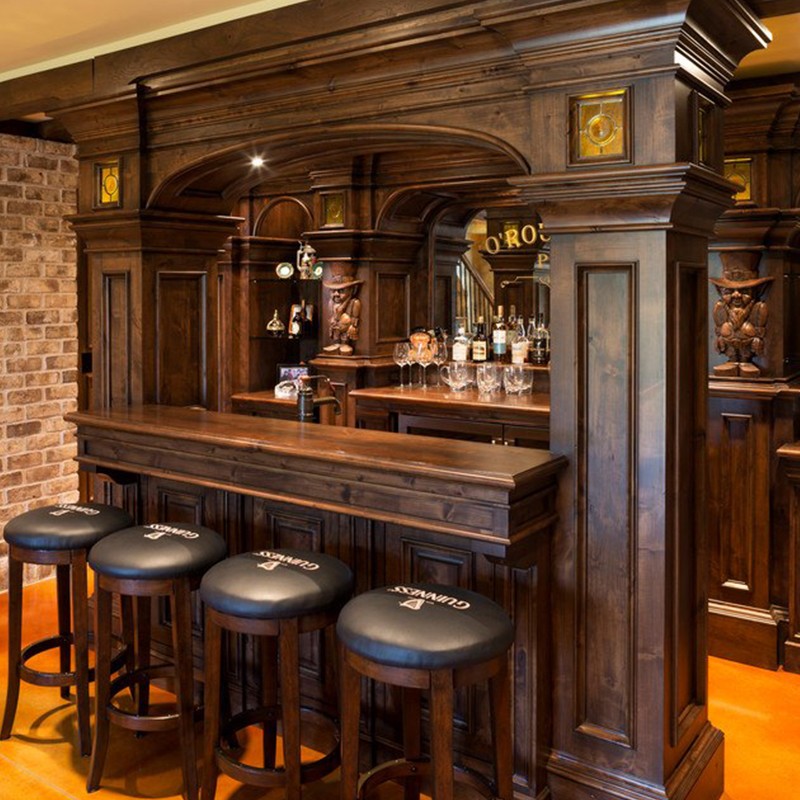
Other matters to note when installing a bar cabinet
In addition to reserving space reasonably, the following points should be noted when installing a home bar cabinet to ensure its effectiveness and safety:
1. Reasonable arrangement of the power supply position
As an electrical product, the location of the power socket of the home bar cabinet is very important. It is recommended to plan the location of the power socket in advance before installing the bar cabinet and ensure that the power cord can be connected smoothly. If the bar cabinet shares the same power socket with other electrical appliances, the power load problem should be considered to avoid safety hazards caused by overload use.
2. Moisture-proof measures
The interior of the bar cabinet needs to maintain appropriate humidity to ensure the preservation quality of the wine. Therefore, when installing the bar cabinet, moisture-proof issues need to be considered. Especially in areas or seasons with high humidity, appropriate moisture-proof measures should be taken, such as laying moisture-proof mats under the bar cabinet, or installing dehumidifiers near the bar cabinet to prevent moisture from affecting the internal environment of the bar cabinet.
3. Fixation and stability of the bar cabinet
Home bar cabinets, especially large bar cabinets, usually need to be fixed to ensure their stability. It is recommended to use professional fixings to firmly fix the bar cabinet to the wall or the ground when installing the bar cabinet to avoid the bar cabinet from tipping over due to accidental collision or earthquake. At the same time, try to avoid placing heavy objects on the bar cabinet to avoid increasing the burden on the bar cabinet.
4. Regular maintenance and cleaning
Home bar cabinet, as a long-term household product, requires regular maintenance and cleaning. It is recommended to check the vents, heat dissipation system and sealing of the bar cabinet every 3-6 months, and clean up dust and debris in time to ensure the normal operation of the bar cabinet. In addition, for the wine stored in the bar cabinet, its status should also be checked regularly to ensure that its quality is not affected.
How does Gagaluna ensure high quality at a low cost?
Our strength lies in efficient production, skilled craftsmanship, and direct factory operations. Gagaluna combines smart sourcing of materials with advanced machinery and strict quality control. By manufacturing in-house in Foshan, China, we maintain high standards while keeping prices low. Wholesale buyers benefit from our expertise, competitive quotes, and reliable supply chain.

